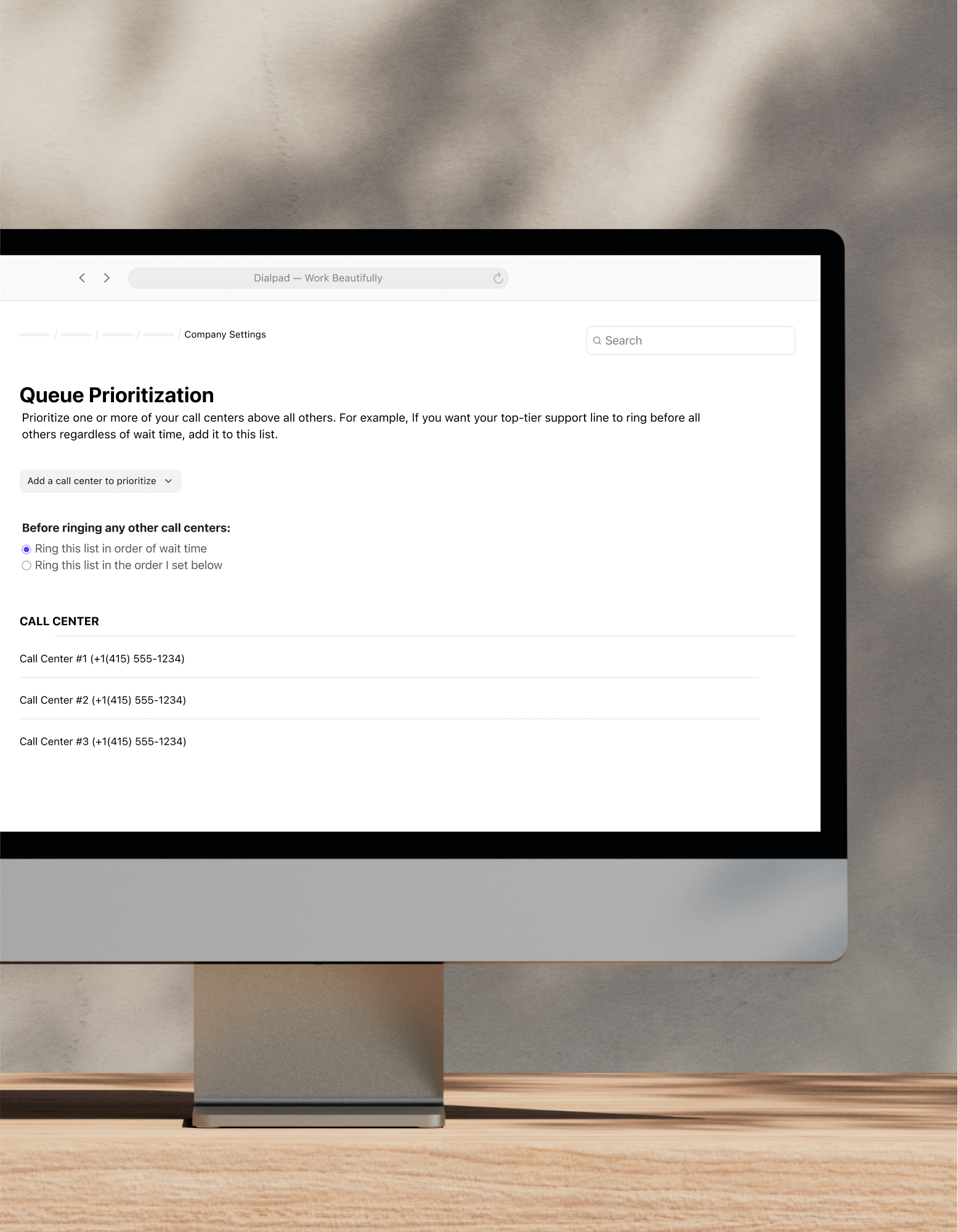
Inbound call center: An in-depth guide
Getting a high volume of inbound calls? Learn how to empower your inbound contact center agents—and see how Dialpad Ai Contact Center's platform can work for your organization!
An inbound contact center is a must for any business that gets a lot of phone calls, emails, and messages from customers and prospects.
Whether you operate a small business or a large organization, having a good inbound calling strategy can make or break your customer experience (and retention rates). And the question to ask here is: can your customers interact easily with your business and get the help or answers they need, no matter when they’re reaching out?
In this guide, we’ll walk through what today’s inbound contact center looks like (including why they’re called contact centers and no longer call centers)—and how to set one up for your business.
What is an inbound contact center?
At its core, an inbound contact center is a team of agents that responds to customers (typically existing customers) who reach out to a business. From incoming calls to live chat messages and social media DMs, your inbound contact center is responsible for answering these messages and calls—and ultimately providing a good experience for your customers (and potential customers).
Inbound contact center agents used to be equipped with just phones to take phone calls, but nowadays, it’s much more common for them to be using contact center software that allows them to not only take phone calls, but also do other things like instant messaging and checking voicemails and missed calls:
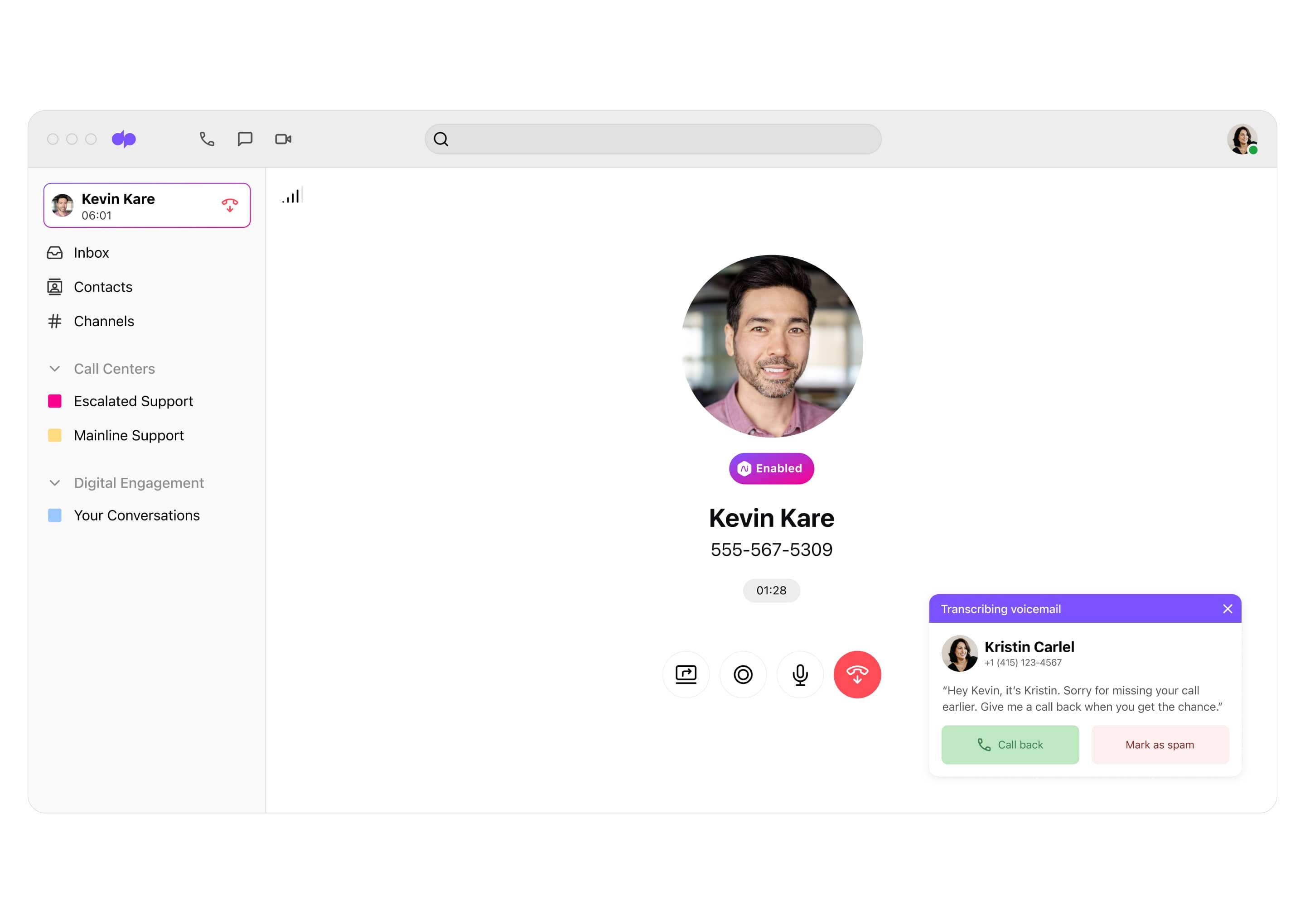
👉 Dialpad tip:
Traditionally, contact centers were referred to as “call centers,” because they dealt with phone interactions. Today, inbound contact centers have expanded beyond that, allowing customers to communicate on the channels they prefer—whether it’s voice, email, chat, or SMS/MMS messaging. (You may hear these referred to collectively as a multichannel or omnichannel experience.)
And beyond just your team of agents handling those inbound calls, there are also automations and features that you can use to handle those calls. For example, an automatic call distributor (sometimes referred to as a virtual receptionist or an IVR / interactive voice response routing system) can help your callers guide themselves to the right people or departments—without needing your staff to manually route every call.
(You don’t always have to have your own inbound contact center either. There are many vendors out there that offer creative and budget-friendly inbound call center services and contact center outsourcing.)
If you need an inbound contact center, but are tight on budget or staff, you could outsource. Learn more about BPO, or business process outsourcing, from our VP of Customer Experience.
How does an inbound call center platform work?
Now you know the purposes of both outbound and inbound contact centers, it’s time to think about the tools you need to empower those teams.
Inbound call center software is basically software that's specifically designed to improve call flow and inbound messaging efficiency. Typically, these solutions have built-in call management features like call routing, agent assistance, and call monitoring to make the contact center or call center experience better for both your agents and customers.
What’s the benefit of investing on an inbound call center platform??
Inbound call center solutions like Dialpad Ai Contact Center free up your agents to manage the inbound customer communications that need an actual person's help—across multiple digital channels, from one simple interface. The result? Simplified workflows and streamlined customer service experiences that save time, money, and improve engagement.
What is the difference between inbound and outbound contact centers?
Contact centers are typically divided into two types: inbound and outbound. For companies or departments that do a lot of outreach (commonly sales teams), an outbound contact center service is essential.
The main difference between the two contact center models is of course, the direction of engagement. An inbound contact center handles conversations initiated by your customer or prospect, while in an outbound contact center, the onus is on your company to make the first move.
👉 Quick note:
The type of call center or contact center you need depends on what kind of communications you need it for—and contrary to popular belief, outbound contact centers aren’t all just for sales outreach and inbound contact centers aren’t all for customer support! There are companies that use hosted contact centers to handle employee or internal communications too! Long story short: it’s all about communication—if your business receives lots of inbound queries, no matter if they’re from customers or not, you could use a contact center to handle it.
Inbound contact center use cases: A few examples
Often the first thing that comes to mind when we think about inbound contact centers is customer service (for example, a customer calls a retailer because the item they ordered is damaged or faulty). But as we touched on earlier, inbound contact centers can have a wide range of use cases.
Customer service
Of course, inbound calling is probably most well known for this use case. But why is it so important for providing exceptional customer service? Well, it might be because traditionally, a phone call was the easiest way for a customer to reach a company.
Whether your caller needs support services, has a scheduling or appointment question, or wants to make a cancellation request, they expect to be able to do that over the phone with your customer service representatives.
One of the benefits of using a contact center platform instead of just a phone is that beyond connecting the phone call or message, it also lets you gather useful data. For example, in Dialpad, you can see analytics like how many calls your business is getting (and plan your inbound customer service staffing more effectively so your agents don’t get overwhelmed):
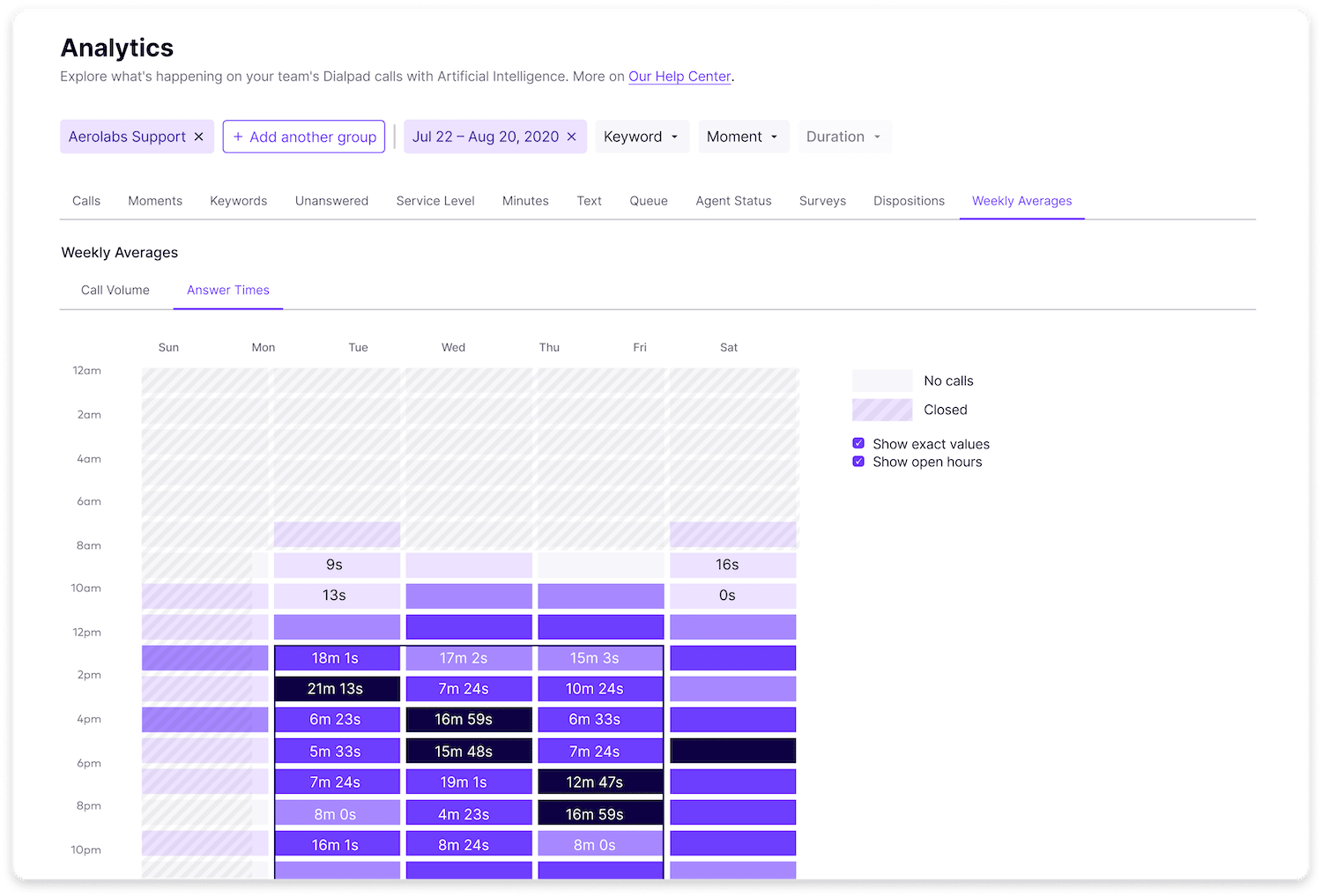
But beyond data, there’s other neat contact center functionality that can help you provide a better customer experience. For instance, say your phone agents are getting lots of tricky questions about things like pricing. You can’t be on every single call with them to coach them through these conversations—so what can you do?
Dialpad Ai not only transcribes all your calls in real time—which allows supervisors to monitor how inbound calls are progressing:
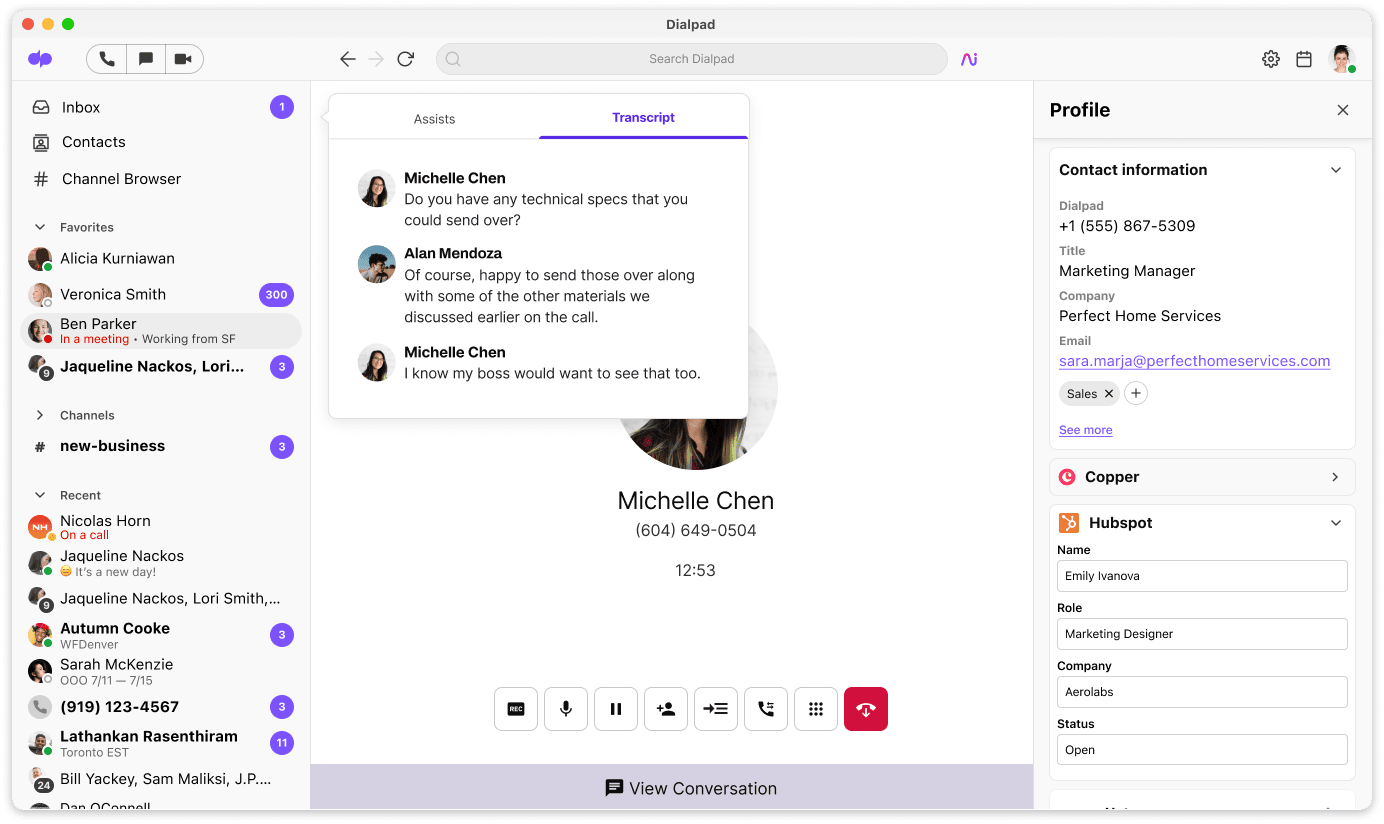
It also allows you to create RTA (Real-time Assist) cards, which are essentially cheat sheets for your agents that pop up automatically when certain keywords are spoken on a phone call. Let’s say your agents are having trouble with pricing questions when people call in. You can create an RTA card with detailed notes about your pricing packages, and set it to trigger automatically on your agents’ screens when the customer says “price,” “pricing,” and “cost!”
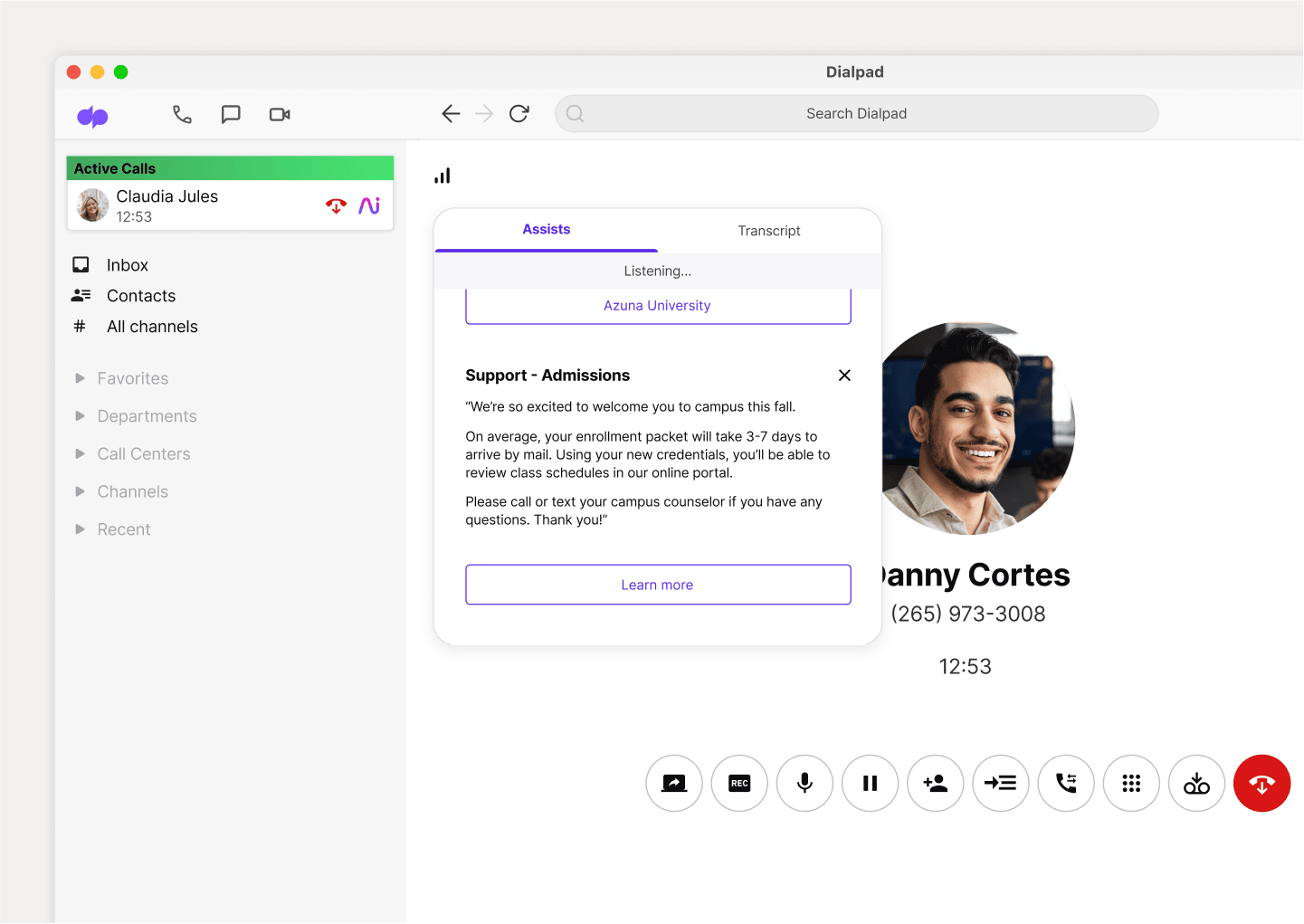
IT help desk
If your business is very tech-focused (or just uses a lot of software in its day-to-day work), then IT issues and tech support questions are going to arise.
So better be prepared, right? Whatever software or IT tool you’re using (or selling), your employees and customers will expect to be able to contact a knowledgeable IT help desk when any issues come up.
That could be a system issue, software issue, or infosec request, for example. Contact center agents need to be available to help customers through any technical support issue they may have. (If you can combine this with a ticketing software, even better.)
Unified communications platforms can be a great resource for technical support teams because in addition to voice calls, IT team members can also use video meetings and screen sharing to troubleshoot more complex technical issues.
One unique thing about Dialpad is how easy to use and accessible its analytics are. Want to see what keywords or queries your contact center is getting the most frequently? You can see that, right in your online account—no need to ask your provider to export any files or spreadsheets:
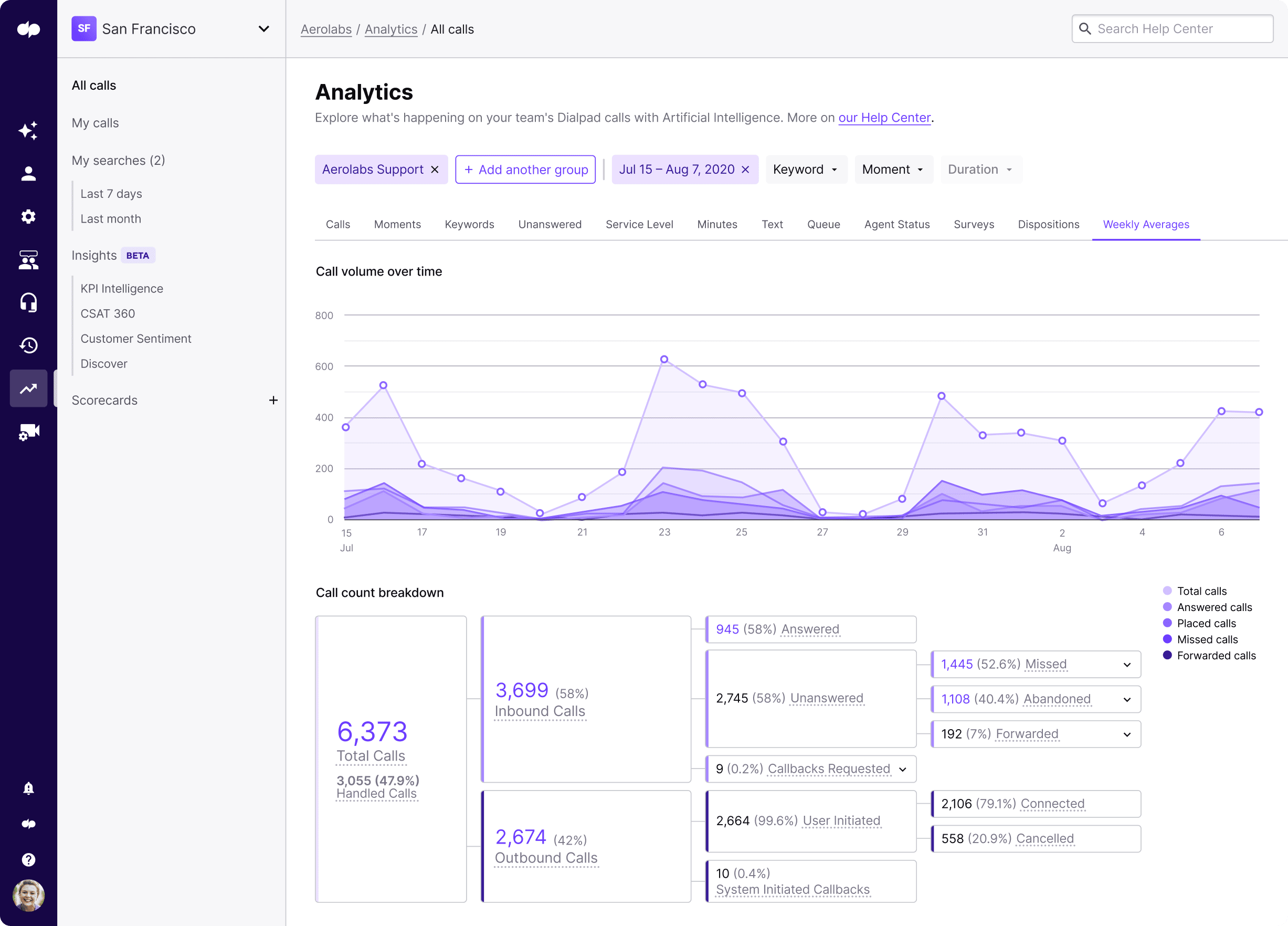
Feedback
Last, but certainly not least, let’s not forget about the importance of feedback.
This is less common nowadays, but traditionally, companies could use inbound contact centers to receive feedback about products and service from your customers. It’s probably more common to see these feedback requests through email today, but we still remember when McDonald’s and stores like The Gap had a CTA at the bottom of your receipt asking you to provide your feedback. (Often, you’d be entered into a draw too, as an incentive to get you to let them know about your experience. Remember those?)
Did you know that in Dialpad, you can create custom customer satisfaction (CSAT) surveys to collect feedback from your customers after a phone call? You can customize your survey question, and even give them the option to elaborate on why they gave you the score they did.
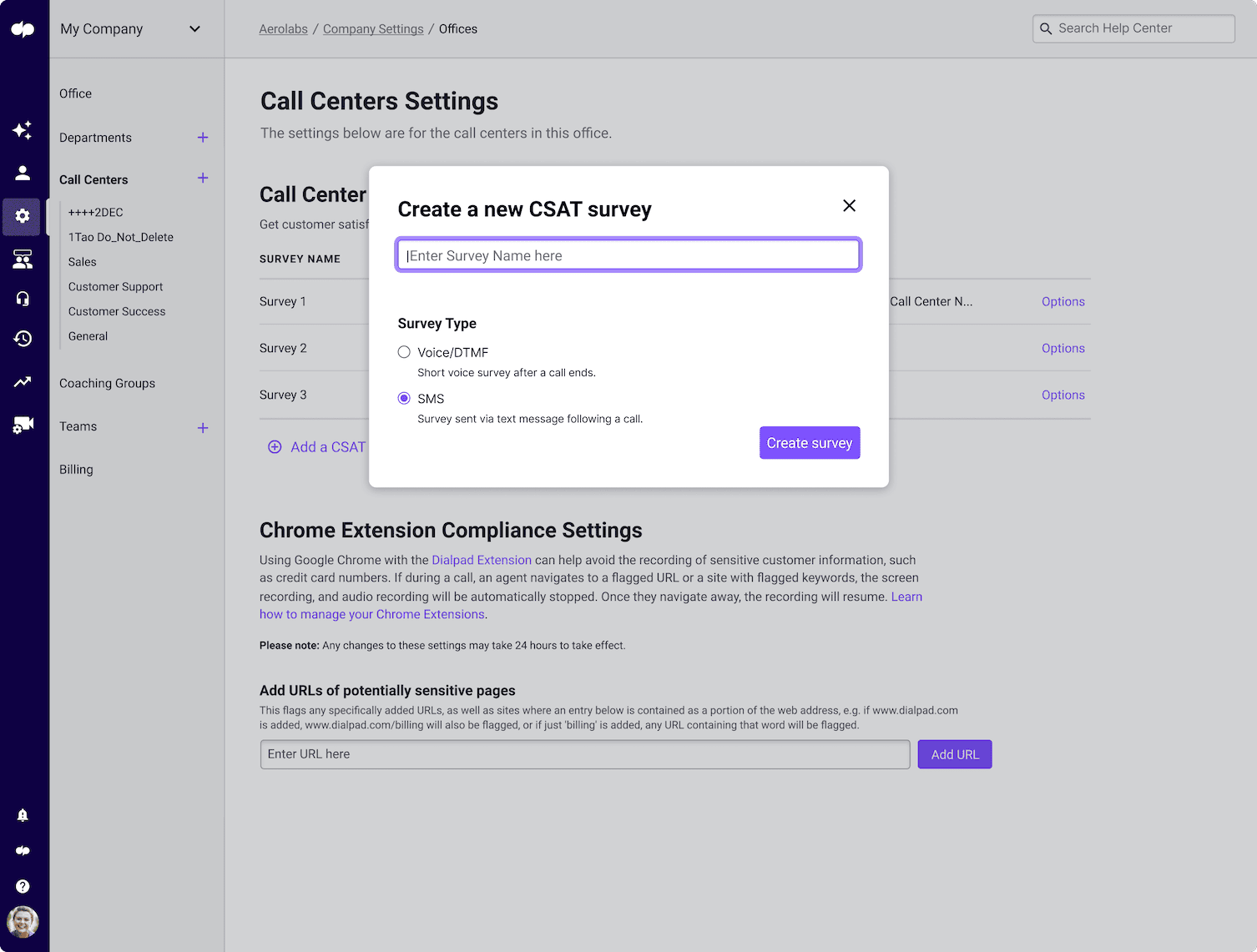
Have an inbound contact center team?
Give your agents the best tools to efficiently (and effectively) provide a good customer experience. Book a demo to see how Dialpad Ai Contact Center works, or take a self-guided interactive tour of the app on your own!
Marketing (people responding to your marketing)
Remember those infomercials on TV that introduce an awesome new product (maybe you remember ShamWow, or even the amazing Slap Chop…)—and then give you a phone number to call?
(“If you call right now, you can get a special promo combo for the low low price of…”)
Well, those companies likely had an inbound contact center (probably an inbound call center specifically) of agents standing by to take phone calls from people interested in that product.
That’s a perfect example of an inbound contact center working hand in hand with marketing to help a business make money.
(Not confident in your inbound agents’ knowledge about your products when prospects call? Create RTA cards for each product and its unique features, and set these to pop up automatically when prospects call in and mention those products’ names!)
Finance
Billing questions, accounts receivable (AR) questions, vendor questions, procurement questions, order processing, payment questions, cancellation questions, refund questions…the list of questions that a Finance team gets can be pretty long.
And being able to answer questions for both internal teams and external clients and contractors quickly is essential. One way to solve this is to set up an inbound contact center to make sure that you’re providing everyone in the company the financial services support they need.
Outbound call center / contact center use cases
Now, let’s look at some outbound call center and contact center use cases, which are also broader than most people think. We often associate outbound contact centers with cold-calling and inside sales teams, but, in reality, there’s more to it than that.
Telemarketing and telesales / lead generation
Okay, let’s start with the contentious one. Telemarketing.
Cold calling for gauging interest is a common use case for outbound contact centers, and even though the effectiveness of this approach is often debated, there are also outbound contact centers that may call prospects to follow up on interest that they’ve shown in that business’ products or services.
👉 Dialpad tip:
If your business does lots of high-volume sales outreach, check out Dialpad Ai Sales, which lets you make more outbound calls in less time and with less effort. (For example, there’s the nifty voicemail drop feature, which lets reps drop a pre-recorded voicemail message instead of spending all that time reciting the same message over and over again.)
For some companies that have established lead generation practices, chances are they’ve been collecting contact information for potential customers already.
Whether it’s from a conference, webinar, or seminar, an outbound contact center is where they’d typically put those contact details to good use.
To make it easier for your outbound agents to dial through and follow up with every conference attendee or list subscriber, you could use a power dialer. For example, Dialpad integrates with CRMs like Salesforce to not only give your outbound agents a power dialer right inside their Salesforce window, but also log all their activities automatically:
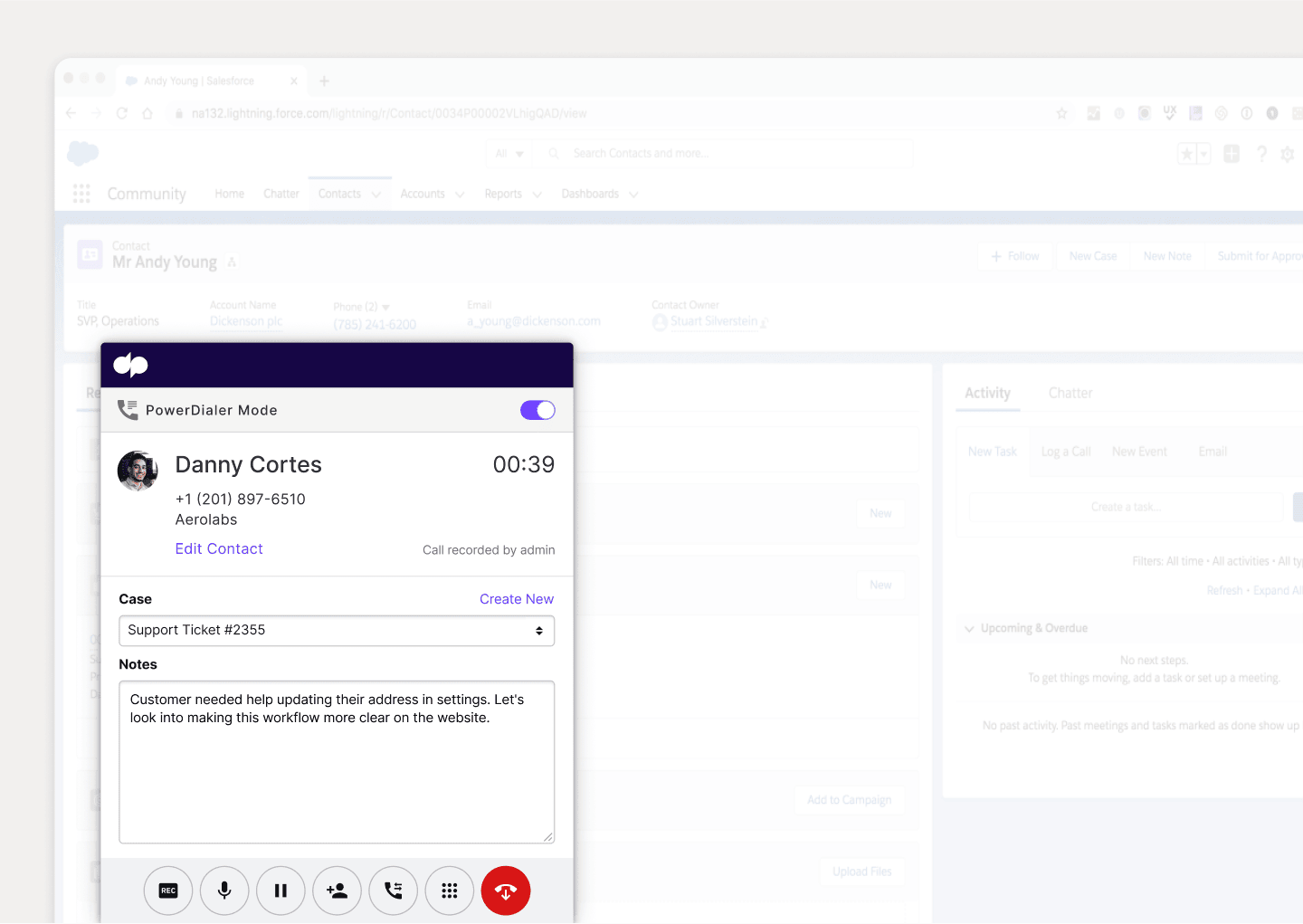
Surveys and market research
Outbound contact centers aren’t just about immediate sales either. Businesses can also use outgoing calls as an opportunity to do customer surveys and market research.
Of course, if you want to survey only a few customers and you have their email addresses anyway, you don’t need this. But if you want to survey and do research at scale, then an outbound contact center can help you speed that process up and reach many more people.
This kind of outbound research is crucial across many sectors, from healthcare to retail, and many in between.
Proactive customer service
What’s even better than being there 24/7 for your customers? Simple—solving their problems before they even have to ask.
Not only does this help with customer satisfaction, it also lightens the load on your inbound contact center, because you’re telling your customers about any outages or issues ahead of time instead of waiting for them to complain to you.
Proactive service does wonders for customer satisfaction and retention, and is well worth integrating into your outbound contact center strategy.
Fundraising
This is a bit of a different one, but one big use case that’s worth mentioning is as a fundraising channel.
Most of us will have engaged with fundraising calls at one time or another. The concept is simple, really. An organization calls their contact list to raise money. For non-profits and activist communities, this is likely a major part of their contact center strategy.
Want to provide an exceptional customer experience? Get your inbound contact center customer-ready
Today’s customers know what they want and expect businesses to deliver. With expectations at an all-time high, you have to equip your inbound call center agents or contact center agents with the right tools.
With a robust contact center or call center solution, you can prepare your business to improve organizational efficiency, increase the revenue generated from your marketing campaigns, and—most importantly—deliver a smooth communications experience to impress your customers and employees.
Need to set up—or upgrade—your inbound contact center?
Book a demo of Dialpad’s contact center software to see how it can work for your business. Or, take a self-guided interactive tour of the app on your own first!